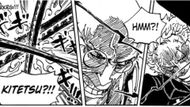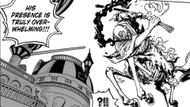Recent visual evidence in One Piece has provided compelling hints about potential family connections between opposing forces in the series. A mysterious color spread featuring a red-haired Shimotsuki character has sparked intense fan speculation about hidden bloodline connections. The deliberate artistic choices seem to bridge the gap between Wano's ancient history and the current World Government leadership.
This One Piece theory proposes that Zoro shares ancestral ties with Saint Ethanbaron V. Nusjuro through the legendary Shimotsuki clan. The evidence ranges from visual similarities in recent manga artwork to deeper cultural and historical connections that suggest these two powerful swordsmen may be distant relatives separated by centuries of conflict.

The foundation of this theory lies in Zoro's confirmed heritage within the Shimotsuki bloodline. Fans have long suspected Zoro's connection to Wano Country, particularly after revelations about Shimotsuki Ushimaru's striking resemblance to the swordsman. The legendary samurai Ryuma serves as the common ancestor linking various members of this distinguished family.
Shimotsuki Kouzaburou, the master swordsmith who created both Wado Ichimonji and Enma, illegally departed Wano 55 years ago and established Shimotsuki Village in East Blue. This migration created the foundation for Zoro's eventual training and development as a swordsman.
Visual Evidence Connects Past and Present in One Piece

The most compelling evidence emerges from comparing recent artistic choices with established character designs. The red-haired Shimotsuki in the color spread of One Piece shares distinctive features that mirror Nusjuro's current appearance when accounting for centuries of aging. Both characters display the refined bearing and intense expressions characteristic of master swordsmen.
Beyond hair coloring, the artistic presentation suggests deliberate connections between Wano's historical figures and current World Government leadership. The positioning and prominence of the red-haired character within the Shimotsuki family portrait imply significant importance to the clan's legacy.
Nusjuro's mastery of the Shodai Kitetsu represents more than just weapon proficiency. One Piece Manga panels clearly show him wielding this cursed blade with the skill of a true swordsman, not merely a political figure. The Kitetsu series of swords carries deep cultural significance within Wano, with each blade possessing a bloodthirsty nature that demands exceptional skill to control.
The fact that a World Government Elder possesses such intimate knowledge of Wano's most dangerous weaponry suggests extensive personal history with the country. His fighting stance and sword techniques mirror those seen in traditional Wano combat styles, further supporting theories of his samurai origins.
Historical Context Supports the Theory

Saint Ethanbaron V. Nusjuro in One Piece holds the title of Warrior God of Finance among the Five Elders. The historical formation of the World Government involved leaders from twenty allied nations moving to Marijoa, with only the Nefertari family choosing to remain in their homeland. If Nusjuro originated from Wano, this would explain how the Shimotsuki clan eventually rose to prominence within the country.
The established pattern of samurai escaping Wano throughout history supports the possibility of earlier migrations, including potential members of the ruling class. This historical precedent strengthens arguments for Nusjuro's potential Wano heritage.
This theory fits within One Piece's established pattern of revealing surprising family connections between characters. The series has consistently used bloodline revelations to add depth to character relationships and provide emotional stakes for major confrontations.
What This Means for the Final Arc
If confirmed, this family connection would fundamentally change how readers perceive both characters. Zoro's quest to become the World's Strongest Swordsman would gain additional significance if it meant potentially surpassing a family member who betrayed their homeland. Meanwhile, Nusjuro's role as a World Government leader would become more complex if his origins trace back to the very country the government has historically oppressed.
The theory remains speculative, but the accumulating evidence creates a compelling case for further investigation. As One Piece approaches its final chapters, revelations about character origins and family connections will likely play increasingly important roles in resolving long-standing mysteries.
